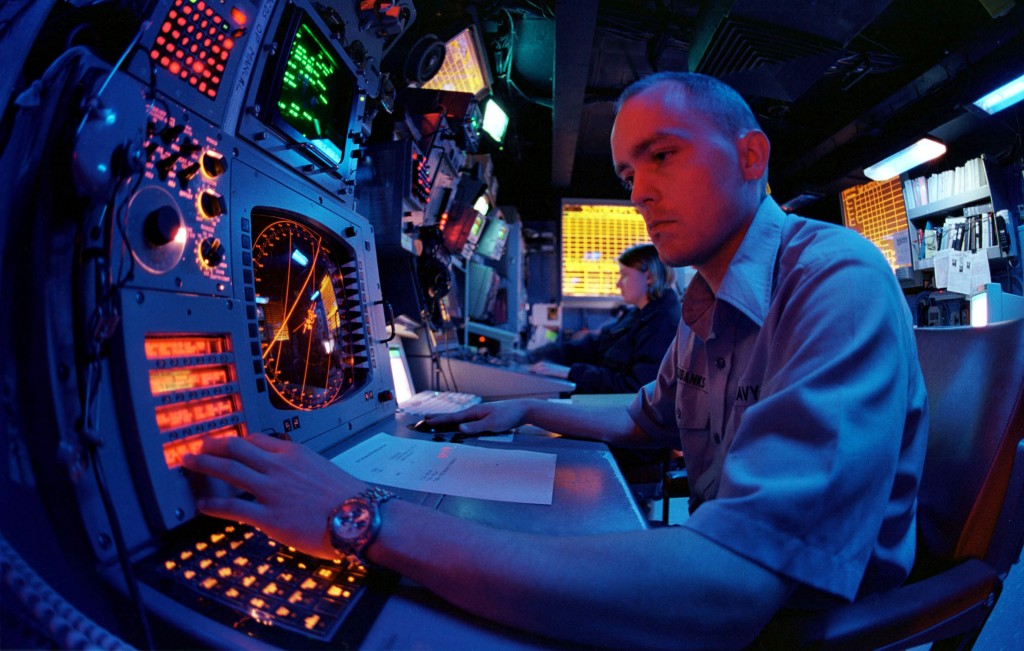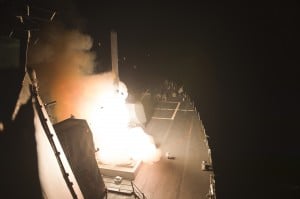Invisible Bullets: The Navy’s Big Problem In Future War
Posted on

A Navy electronic warfare technician.
WASHINGTON: In the brutal naval battles of the future, the first clash of arms will be a clash of electrons. If you don’t win the invisible battle of the airwaves, you can’t win the visible battle of missiles.
Before warships can concentrate their fire on the enemy, they first must communicate with each other. Before they can fire at long range at all, they have to communicate with forward scouts — other ships, satellites, manned aircraft, drones — who can transmit detailed targeting data on enemies beyond the reach of a warship’s onboard radar, typically just 10 nautical miles. (That’s against other ships, which can hide below the horizon: High-flying aircraft and ballistic missiles are detectable hundreds of miles away).
To make the most of all their warships, leaders of the surface Navy have been pushing a concept called “distributed lethality,” summed up as, “if it floats, it fights.” Instead of tying surface combatants — cruisers, destroyers, frigates, and Littoral Combat Ships — to escort duties for aircraft carriers, amphibious warships, and support ships, distributed lethality would send them forward in small Surface Action Groups. The warships would disperse to avoid detection but concentrate their long-range missile barrages on a single target.
Instead of just tracking carrier battle groups, the adversary would have to worry about every missile-armed warship in the fleet. The director of surface warfare, Rear Adm. Peter Fanta, told the Surface Navy Association that the goal is to “make them wonder where that next missile’s coming from. Make them wonder where those damn Americans are today and how many of them are going to hit us from how many different directions.”
The problem is there’s no guarantee the “distributed” forces can communicate when they need to share targeting data or coordinate attacks. No less a figure than the Pentagon’s then-chief of research and engineering, Alan Shaffer, said in 2014 that “we have lost the electromagnetic spectrum.” It’s the spectrum where radio communications and radar detection both operate — as do the myriad electronic warfare systems that detect, deceive, and disrupt them.
“It’s a huge priority,” Rep. Randy Forbes told me. “It’s not just the Pentagon that’s concerned about losing our advantage [in electronic warfare],” the House seapower subcommittee chairman continued. “If you talk to some of the top CEOs at some of our defense contractors, they would take it a step further and say we’ve lost our advantage and now we’re playing catch-up.”

Tomahawk cruise missile launch against Syria
Telltale Emissions
So naval leaders and experts are increasingly concerned that future enemies will be able to detect US forces and then strike them blind and deaf before striking them dead.
“Ships emitting very high-power, unique RF (radio frequency) waveforms that also have significant visual, infrared, and radar signatures — both the ships themselves and their wakes — will be increasingly susceptible to being located, tracked, and attacked from extended range,” former Navy undersecretary Bob Martinage told me. “Over the long run, at a minimum, this suggests a need to move toward less detectable means of sensing and communication.” One model is the “low to no power” concept advocated by his colleagues at the Center for Strategic and Budgetary Assessments, Bryan Clark and Robert Gunzinger. (More on that below.)
Today, we transmit at high power all the time. Since the Cold War ended, US forces have grown accustomed to communicating, sensing, and transmitting at will, unhindered, without regard for who might be listening. But Russia, China, and other potential adversaries are exploiting rapid advances in processing power, sometimes more quickly than the hidebound Pentagon procurement system can. Meanwhile, the Navy is only now reviving its electronic warfare expertise (and the other services are much further behind), a revival embodied in a 2014 document on electromagnetic maneuver warfare.
“Distributed lethality depends on electromagnetic maneuver warfare,” says Jonathan Solomon, senior systems and technology analyst at Systems Planning & Analysis Inc, where he works on Navy surface warfare systems. “The initial phases of a distributed lethality operation will heavily leverage cyber/electronic warfare.”
The two concepts are definitely linked, according to Adm. Philip Davidson, head of Fleet Forces Command. The Navy’s great advantage is its ability to network information from satellites, manned reconnaissance aircraft, drones, and ships to create improved situational awareness (SA), he told the Surface Navy Association: “We’ve got to be able to distribute that tactical SA. We’ve got to be able to defend the networks that distribute that.”
But can we defend the networks? “You raise a very good point about potential C3 [command, control, and communications] network vulnerability with the distributed lethality concept,” Martinage told me. “Adversaries are clearly developing and fielding jammers designed to target key datalinks relied upon by the fleet, as well as anti-radiation homing weapons that target the emitters themselves.” There’s also the possibility of wireless hacking, using the fleets’ own radio transmissions as cover for a cyber attack.
Navy leaders know they have a problem. The goal of distributed lethality is to “deceive, target, and destroy” the enemy, Vice Adm. Tom Rowden, commander of naval surface forces, said at the Surface Navy Association conference. Note the emphasis on deception, which means especially electronic deception: decoys that emit all the telltale signals of a full-size warship, for example, while the actual warships turn off all unnecessary electronics and operate under strict “emissions control,” or EMCON. And, said Rowden, the Navy is looking to find ways to transmit targeting data from ship to ship even when under EMCON.
We have capability gaps — shortfalls — in all those areas, I noted during the Q&A.
“Absolutely, we have gaps,” Rowden agreed.
The Navy is already training for a “contested” electromagnetic environment, said Adm. Davidson. “We did 10 times the amount of operating in a contested and denied EMW/communications/navigation environment here just a few months ago right before we sent [USS] Truman out the door than we did just with T.R. [USS Theodore Roosevelt] at the beginning of the year, and T.R. had made a substantial improvement over forces that went out the door in ’12 and ’13.”
“I don’t want to give too much away here,” he said, but naval forces must now consider “whether they should be preserving their stealthiness or not [e.g. EMCON], limitations in how they can command and control their force, [and] limitations on how they might operate if they don’t have all their sensors.”
Distributed lethality does depend on functioning networks, Davidson acknowledge. “There are some vulnerabilities in a structure like this,” he said, but we cannot devolve the force to to mano a mano, five-inch gun on five-inch gun, if your adversary is able to protect their network” and fire missiles from hundreds of miles away.

Sailors troubleshoot the communications network aboard the USS Vinson
Building The Next Network
If the future fleet wants to win the war of electrons, it can’t just have “a network.” It needs to have multiple, redundant, and resilient networks, said retired Navy commander Bryan McGrath. That way, even when the warships of a Surface Action Group have lost contact with the Pentagon, satellites, and the rest of the fleet, they can still communicate with each other.
“We need to be able to network the computing power of a three-ship SAG separate and apart from any larger network,” McGrath told me. “We need to be able to have limited, local, perhaps UAV [unmanned-aerial-vehicle]-enabled SAG networks.” If you can’t reach a communications satellite, launch an expendable drone to relay radio instead — and accept it’ll probably be shot down once the enemy picks up its emissions.
“We’re not talking about a network that reaches all the way back to the CONUS [continental United States],” said Mark Gunzinger at a December briefing on CSBA’s landmark electronic warfare study. “We’re talking about local area networks that are very LPI/LPD [low probability of interception/low probability of detection. That network can be very difficult for an enemy to break.”
“We’re going to be reliant to a much greater degree on ‘edge networks,’ which is these little local area networks… instead of having the reach back to a force commander ashore somewhere,” added Gunzinger’s co-author, Bryan Clark. “That requires a level of autonomy[:] These systems are going to have to make a lot of decisions on their own.”
These frontline networks would rely on tight-beam, lower-power transmissions with constantly changing waveforms, much more difficult to intercept than traditional 360-degree broadcasts. The only parts of the system broadcasting at high power in all directions, said Solomon, should either be expendable — drones — or located well out of enemy’s reach. Most ships and aircraft would passively receive the broadcast data but transmit back only infrequently and at low power, aiming at the nearest relay.
When two ships were particularly close and the weather was clear, they could even switch from radio entirely to signaling lasers. Likewise, traditional radar could be replaced by low-power or even passive sensors, which would have a better chance of detecting the enemy without being detected in return. Alternatively, you could separate transmitter and receiver: An expendable drone could send out a high-power active radar beam — calling enemy attention to itself — and then the fleet could passively detect that beam’s reflection off the target. The secret to success isn’t simply turning everything off, said Adm. Davidson, but carefully managing your emissions to meet the tactical need of the moment.
Likewise, not all networks need be created equal, said Solomon. Coordinating self-defense against incoming supersonic missiles would require sharing real-time updates. Coordinating an attack would require only near real-time updates on the target’s position, just accurate enough the missiles could home in on their own for the final approach. Exchanging plans and orders needn’t be real time at all — if commanders could overcome the need to micromanage.
“Empowering the lowest level to take the initiative [creates] a decision cycle that’s faster and more hardened than someone who’s commanding from afar,” said Solomon. It’s also in keeping with the oldest traditions of the Navy, which gave a ship’s captain tremendous independence in the days before the radio. Modern US doctrine calls this “mission command,” in contrast to traditional “command and control”: Rather than try to “control” subordinates, a commander gives them their mission and wide leeway to accomplish it.
“The SAG [Surface Action Group] needs to train to do ‘carry out your last set of orders’ mission command,” said McGrath. For all our marvelous modern sensors, he said, “high end warfare is likely to devolve into a ‘knife fight in a dark room’ after each side has done a number on the other’s satellites.” When the technology is taken away, naval officers have to fall back on old-fashioned ruthlessness and independence of mind.
Subscribe to our newsletter
Promotions, new products and sales. Directly to your inbox.
